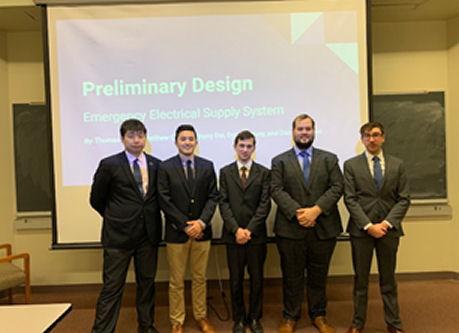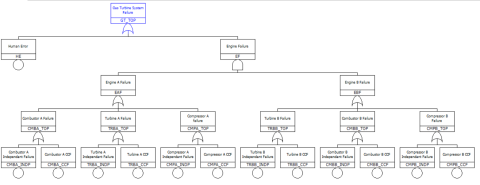The goal of this project is to explore alternatives to Emergency Diesel Generators (EDGs) through risk and cost assessments, and suggest a system that meets current NRC safety standards while decreasing the costs of the power system. Systems that were explored included gas turbine generators, Compressed Air Energy Storage (CAES), Pumped Storage Hydropower (PSH), and Flywheel Energy Storage (FES). Combined systems were also considered. AIMS-PSA was used in order to analyze the different power systems via probabilistic risk analysis while inserted into a model nuclear power plant. Figure 1 shows the initial fault-tree model representing a gas turbine system, used for analysis. It is assumed that all systems would be installed into new construction, and so cost estimates are provided in terms of overnight cost.
Team: Thomas Buzek, Matthew Clark, Anthony Dai, Dylan Garvey, Daniel Leiman, Ed Tremblay
Project Advisor: Dr. Hyun Gook Kang

Members of the design group
Project Motivation
In order to decrease the amount of greenhouse gases regularly released into the atmosphere in a reasonable amount of time, it is absolutely necessary to encourage more widespread adoption of nuclear power as a clean energy source. This can be made more attractive by decreasing construction costs of new plants where possible, and increasing safety to garner greater public support. A key location to reduce costs is in the Emergency Power Supply System (EPSS), where Emergency Diesel Generators (EDGs) are currently the standard solution. While effective at mitigating Loss of Offsite Power (LOOP) accidents and Station Blackout (SBO) accidents, diesel generators are prohibitively expensive, costing between $80-100 million per system. Replacing EDGs with another source of emergency power has the potential to significantly decrease the overall plant construction cost, and potentially even reduce licensing costs.

Figure 1 - Example of a fault-tree model of a gas turbine system
Project Description
The goal of this project is to explore alternatives to Emergency Diesel Generators (EDGs) through risk and cost assessments, and suggest a system that meets current NRC safety standards while decreasing the costs of the power system. Systems that were explored included gas turbine generators, Compressed Air Energy Storage (CAES), Pumped Storage Hydropower (PSH), and Flywheel Energy Storage (FES). Combined systems were also considered. AIMS-PSA was used in order to analyze the different power systems via probabilistic risk analysis while inserted into a model nuclear power plant. Figure 1 shows the initial fault-tree model representing a gas turbine system, used for analysis. It is assumed that all systems would be installed into new construction, and so cost estimates are provided in terms of overnight cost.

Figure 2 - Normalized Failure Rates vs Cost
Results and Accomplishments
After comparing several different composite systems, it has been the group’s conclusion that a gas turbine generator augmented by a battery backup system is the most likely candidate. It was determined that this system will result in an overall plant failure rate of 4.05E-6 failures per year, down from 5.57E-6 for a diesel generator based system. It is estimated this system will cost between $30-40 million for the gas turbine generators, and between $10-15 million for the battery augmentation system. The battery augmentation was added, in order to accommodate for the 2-minute startup time of the gas turbines. The batteries can provide direct power to emergency coolant pumps and other equipment as needed to maintain safe plant operation. A risk vs cost comparison is shown for the various system configurations in Figure 2.